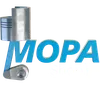TACHOMETER ELECTRIC Display for Marine and Industrial Engines
A Display is the central human–machine interface on an engine control panel. It consolidates vital operating data into a readable format so crews and operators can make fast, informed decisions. In marine engine rooms, on bridge consoles, and in power-generation skids, a robust Display provides instant insight into speed, load, temperatures, pressures, and alarms. Among the most critical readouts is engine speed, typically provided by a TACHOMETER ELECTRIC circuit, which allows operators to monitor rpm with high accuracy. This information underpins safe maneuvering, efficient fuel use, and compliance with operating limits.
As a component category, Displays range from compact analog gauges to programmable multi-function TFTs integrated via CAN bus. Regardless of form, they are designed to withstand vibration, electrical noise, moisture, and temperature fluctuations common to diesel engine and marine engine environments. A well-specified Display enables precise control, reduces diagnostic time, and helps extend engine service life.
Technical function: how the Display and TACHOMETER ELECTRIC work in an engine
The Display aggregates signals from the engine and related systems, converts them into engineering units, and presents them clearly to the operator. For speed measurement, a TACHOMETER ELECTRIC stage counts pulses from a frequency source—such as a magnetic pickup on the flywheel ring gear, a Hall sensor on the crankshaft, or the alternator W-terminal—and translates that frequency into rpm. Many modern panels also acquire rpm from the ECU via J1939 or NMEA 2000, ensuring consistent values across devices.
Signal acquisition and processing
Depending on the installation, Displays accept mixed input types: frequency inputs for the TACHOMETER ELECTRIC function, analog 0–5 V or 4–20 mA for pressure and temperature, and digital/CAN for ECU data and status. The instrument filters noise, applies calibration factors (pulses-per-revolution, scaling, damping), and updates the screen at a stable rate so rpm is responsive yet readable. In a diesel engine generator set, the tachometer readout directly correlates to output frequency (50/60 Hz), while on a marine engine driving a propeller, it supports safe maneuvering and cavitation control.
Display, alarms, and system integration
Beyond showing rpm, modern Displays integrate alarm logic (e.g., overspeed warning), annunciation, backlight dimming for night operations, and data logging of events. Interfaces typically include CAN (J1939), NMEA 2000 for marine networks, and sometimes Modbus. This allows a TACHOMETER ELECTRIC value to be cross-checked with ECU data and shared across bridge and engine room panels. Environmental protection (often IP65–IP67 on the front) and high-contrast, sunlight-readable screens ensure reliability in harsh conditions.
- · Accurate rpm via TACHOMETER ELECTRIC sensors and ECU data.
- · Wide 12/24 VDC supply and reverse-polarity protection.
- · J1939 and NMEA 2000 connectivity for marine engine integration.
- · Configurable alarms, including overspeed and critical shutdown notices.
- · Sunlight-readable TFT/LCD and dimmable backlighting.
- · IP-rated sealing; vibration and EMI/EMC resistance.
- · Fast update rates with stable filtering for smooth readouts.
- · Plug-compatible connectors and clear harness labeling.
Importance for engine operation, reliability, and safety
An accurate Display is fundamental to safe engine control. If the TACHOMETER ELECTRIC reading drifts or drops out, operators can unintentionally run outside recommended rpm, increasing mechanical stress, fuel consumption, and the risk of overspeed events. In propulsion, incorrect rpm makes it harder to maintain maneuvering margins and can contribute to propeller damage or cavitation. On generator sets, misread speed can cause frequency deviations, risking sensitive loads and grid stability.
Degraded screens, failing backlights, or intermittent inputs lead to poor situational awareness. Misinterpreted alarms or unreadable indicators can delay response to low oil pressure, high coolant temperature, or charge alternator failures, all of which accelerate wear and can cause avoidable downtime. Keeping the Display and its TACHOMETER ELECTRIC circuitry in top condition preserves the engine’s reliability and extends component life by ensuring operators stay within safe operating envelopes.
Advantages of OEM spare parts suitable for Display
When replacing or upgrading Displays, selecting OEM spare parts suitable for your engine model ensures the instrument is dimensionally, electrically, and functionally matched to the application. Calibrations, firmware, and connectors are aligned with the engine maker’s specifications, so the TACHOMETER ELECTRIC function reads correctly from your magnetic pickup, alternator W-terminal, or J1939 source without custom workarounds.
Using OEM parts minimizes commissioning time, reduces integration risk, and supports consistent performance across your fleet. Environmental sealing ratings, backlight life, and EMC robustness are verified at the component level, which protects uptime in high-vibration diesel engine installations and on marine engine panels exposed to humidity and salt air. The result is predictable reliability, fewer nuisance alarms, and tighter control of total cost of ownership.
- · Correct scaling and pulse-per-rev presets for accurate rpm.
- · Verified compatibility with harnesses, sensors, and ECUs.
- · Stable firmware and long-term parts availability.
- · Reduced troubleshooting, faster swap-out, less downtime.
- · Maintained compliance with class and EMC requirements.
MOPA: your partner for OEM spare parts Display
MOPA supplies OEM parts for diesel and gas engines with a strong focus on speed, quality, and procurement security. We provide Displays and related TACHOMETER ELECTRIC components suited to marine engine control panels and industrial power applications, backed by technical clarity, documentation, and traceable sourcing. Our logistics network enables rapid dispatch, while our specialists help you identify the correct part number, interface standard, and calibration to keep your equipment running.
Conclusion
A dependable Display with a precise TACHOMETER ELECTRIC readout is essential for safe, efficient operation of marine and industrial engines. It empowers crews to keep rpm, load, and temperatures within limits and to act on alarms without delay. With OEM spare parts suitable for Display installations, you safeguard performance, extend service life, and protect your maintenance budget—supported by MOPA’s fast, secure supply of OEM parts for diesel and gas engines.


